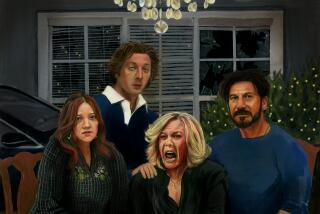Art, deep as memory / At the holidays, the arts become especially personal, shot through with ritual and family tradition. On these pages, six encounters with words, images and music that left their mark on our writers.
For some reason, people like to downplay the importance of television during the holiday season. As if the medium cheapens the message somehow, as if a 42-inch plasma flat screen couldn’t possibly occupy the same spiritual space as a creche or a menorah. Which is pretty silly when you think about the actual logistics of the holiday season (though all those flat screens have removed the perfect surface for said creche and menorah).
Television plays a crucial role, particularly in the evocation of Christmas spirit. Ask yourself: Is it really Christmas until you’ve seen “It’s a Wonderful Life” or “Miracle on 34th Street” or, in my case, “A Christmas Carol?” The answer is: No.
There is something so soothing about these films, their black-and-white texture, their black-and-white morality. Those were the days when filmmakers understood the importance of catharsis, not to mention miracles. Both are key to celebrating Christmas -- just ask Beethoven, or Handel, or any of the apostles for that matter.
When I was a child, my family took catharsis to the extreme. For us, the most pivotal TV experience was the annual viewing of “A Christmas to Remember,” the 1978 TV movie starring Jason Robards and Eva Marie Saint. In it, Rusty, a young city boy, is shipped off by his tarty mother to his grandparents’ farm, mid-Depression. Daniel Larson (Robards) is a crusty, angry old guy; his wife, Emma (Saint), is nicer but still a bit broken herself. They have lost a son, you see, after he tangled with the old man and ran off to join the Army. Since then Daniel has been a hermit, refusing to attend church or join in the little farm community in any way.
After a few initial run-ins, Rusty softens him up a bit, until late on Christmas Eve, Daniel decides to surprise Emma by donating her harpsichord to the church, like she’s been wanting to do for years. Only he and Rusty get lost in the snow and it seems an impossible task until out of nowhere appears . . .
See, I can’t write any more without dissolving right here in print. It’s a killer, that “Christmas to Remember,” especially the final scene, when a broken-toothed, hollow-eyed Robards plays the song he always played for his dead son. “Pony boy, pony boy . . . “
There I go again. But this is exactly why we watched it: It was the only movie guaranteed to make every one of us, especially my father, cry. And not just a few shining drops but great choky sobs that the whole family could share in, then laugh about in relief.
No doubt it says something about the general dysfunction of my family that we felt the need to have a really good cry each and every Christmas, but there it is. Emotions run high during holidays, and catharsis has a way of keeping things on a more even keel. My brother and I would tease my father about his breaking down, but we found it somehow reassuring. Even in adulthood, there is something exquisite about seeing a parent, particularly a father, cry over a movie or a book or a poem. It is a vivid reminder of the power art has over us all, how shared narrative allows us to access feelings of loss and joy and fear and hilarity in a way we cannot always do on our own.
My father is gone now, and it is difficult to find “A Christmas to Remember” on TV, which is a shame because it is a really good movie. But I have the tape he made -- I cannot seem to find it on DVD -- and I watch it every Christmas and cry, for love and loss and the wonder of it all.
--
More to Read
The biggest entertainment stories
Get our big stories about Hollywood, film, television, music, arts, culture and more right in your inbox as soon as they publish.
You may occasionally receive promotional content from the Los Angeles Times.











